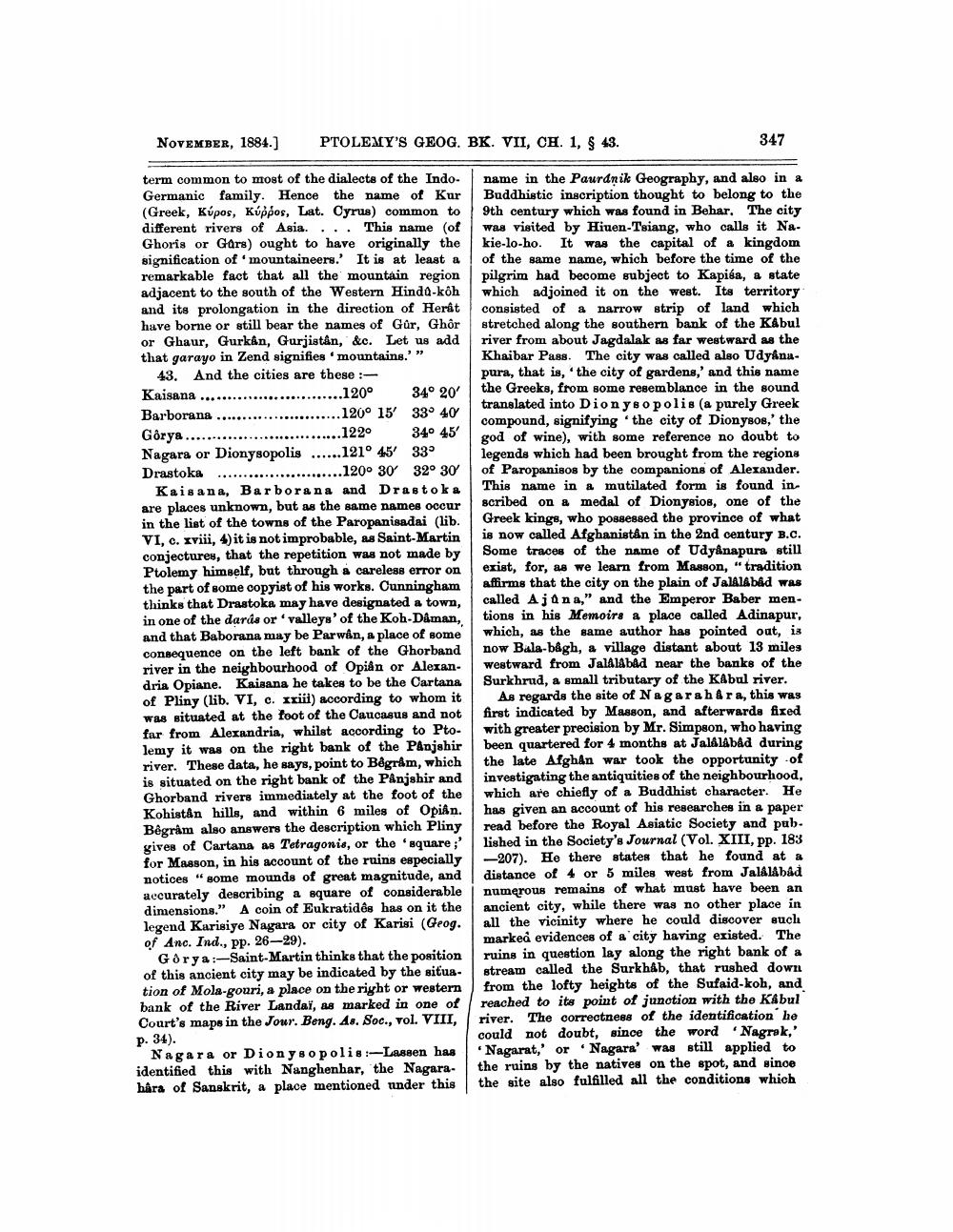________________
NOVEMBER, 1884.]
PTOLEMY'S GEOG. BK. VII, CH. 1. & 43.
347
term common to most of the dialects of the Indo- name in the Pauranik Geography, and also in a Germanic family. Hence the name of Kur Buddhistic inscription thought to belong to the (Greek, Kúpos, Kúppos, Lat. Cyrus) common to 9th century which was found in Behar. The city different rivers of Asia. ... This name (of was visited by Hiuen-Tsiang, who calls it NaGhoris or Gars) ought to have originally the kie-lo-ho. It was the capital of a kingdom signification of mountaineers. It is at least a of the same name, which before the time of the remarkable fact that all the mountain region pilgrim had become subject to Kapisa, a state adjacent to the south of the Western Hinda-koh which adjoined it on the west. Its territory and its prolongation in the direction of Herät consisted of a narrow strip of land which have borne or still bear the names of Gur, Ghôr stretched along the southern bank of the Kábul or Ghaur, Gurkan, Gurjistân, &c. Let us add river from about Jagdalak as far westward as the that garayo in Zend signifies mountains.'” Khaibar Pass. The city was called also Udyana43. And the cities are these :
pura, that is, the city of gardens,' and this name Kaisana ...........................120° 34° 20' the Greeks, from some resemblance in the sound Barborana ........................120° 15' 330 40
translated into Dionysopolis (a purely Greek ..122°
compound, signifying the city of Dionysos,' the Gôrya..............
34° 45
god of wine), with some reference no doubt to Nagara or Dionysopolis ...... 121° 45' 33°
legends which had been brought from the regions Drastoka ........................120° 30 32° 30 of Paropanisos by the companions of Alexander.
Kaisana, Barborana and Drastoka This name in a mutilated form is found in are places unknown, but as the same names occur scribed on a medal of Dionysios, one of the in the list of the towns of the Paropanisadai (lib. Greek kings, who possessed the province of what VI, c. xviii, 4) it is not improbable, as Saint-Martin is now called Afghanistan in the 2nd century B.C. conjectures, that the repetition was not made by Some traces of the name of Udyanapura still Ptolemy himself, but through a careless error on exist, for, as we learn from Masson, "tradition the part of some copyist of his works. Cunningham affirms that the city on the plain of JalAlAbad was thinks that Drastoka may have designated a town, called Ajana," and the Emperor Baber menin one of the dards or valleys' of the Koh-Daman, tions in his Memoirs a place called Adinapur, and that Baborana may be Parwân, a place of some which, as the same author has pointed oat, is consequence on the left bank of the Ghorband now Bala-bagh, a village distant about 13 miles river in the neighbourhood of Opian or Alexan- Westward from Jalalabad near the banks of the dria Opiane. Kaiaana he takes to be the Cartana Surkhrud, a small tributary of the Kabul river. of Pliny (lib. VI, c. Irit) according to whom it As regards the site of Nagarah & ra, this was was situated at the foot of the Caucasus and not first indicated by Masson, and afterwards fixed far from Alexandria, whilst according to Pto. with greater precision by Mr. Simpson, who having lemy it was on the right bank of the Panjahir been quartered for 4 months at JalAlAbad during river. These data, he says, point to Bågram, which the late Afghan war took the opportunity of is situated on the right bank of the Pånjshir and investigating the antiquities of the neighbourhood, Ghorband rivers immediately at the foot of the which are chiefly of a Buddhist character. He Kohistân hills, and within 6 miles of Opiân. has given an account of his researches in a paper Bêgråm also answers the description which Pliny read before the Royal Asiatic Society and pub. gives of Cartana as Tetragonis, or the square ;' lished in the Society's Journal (Vol. XIII, pp. 183 for Masson, in his account of the ruins especially -207). He there states that he found at a notices "some mounds of great magnitude, and distance of 4 or 5 miles west from Jalálábad accurately describing a square of considerable numerous remains of what must have been an dimensions." A coin of Eukratides has on it the ancient city, while there was no other place in legend Karisiye Nagara or city of Karisi (Geog. all the vicinity where he could discover auch of Anc. Ind., pp. 26-29).
markea evidences of a city having existed. The Gorya :-Saint-Martin thinks that the position ruins in question lay along the right bank of a of this ancient city may be indicated by the situa- stream called the Surkhåb, that rushed down tion of Mola-gouri, a place on the right or western from the lofty heights of the Sufaid-koh, and bank of the River Landai, as marked in one of reached to its point of junction with the Kábul Court's maps in the Jour. Beng. As. Soc., vol. VIII, river. The correctness of the identification he p. 34).
could not doubt, since the word 'Nagrak.' Nagara or Dionyso polis:--Lassen has Nagarat,' or Nagara' was still applied to identified this with Nanghenbar, the Nagara the ruins by the natives on the spot, and sinoe hâra of Sanskrit, a place mentioned under this the site also fulfilled all the conditions which




